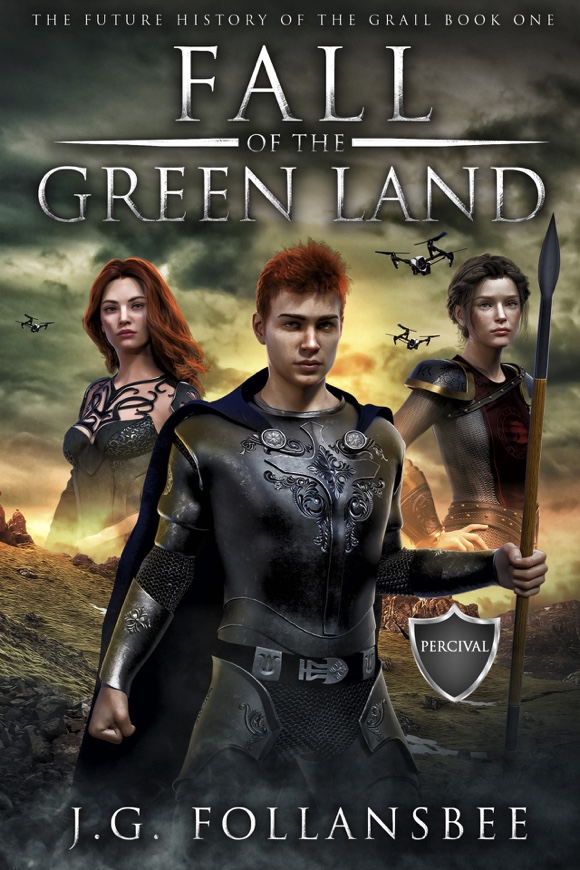Genre: Sci-Fantasy, Epic Fantasy
Reviewer: Scott
Get It On Amazon
About The Book
Sir Percival Rathkeale, the red-haired knight of Viridiae, the Green Land, seeks the lost Grail, a powerful device critical to the survival of his king, his country, and the planet. Merlin, the king’s chief science advisor, discovers new clues to the Grail’s location.
The king appoints Sir Percival to a new expedition to find the Grail. With Sirs Galahad and Bors, and Dame Lancelot du Lac, the strongest warrior in the land, Percival sails for the island of Koda, where he faces dark forces determined to oppose his mission and usurp the king. Will Percival find the Grail, restore his country, and save the world?
Fall of the Green Land, the first novel in the fantasy series The Future History of the Grail, re-imagines the King Arthur legends, placing them a thousand years in the future. The second and third books are War for the Green Land and Return to the Green Land.
The Review
I first met Joe Follansbee in 2020, when he answered a call for stories for our Fix the World anthology with a wonderful tale about a nunnery engaged in saving the world – by seeding clouds for rain using a flotilla of drones. The image of a bunch of nuns hunched over flying stations bathed in their blue light made me giggle.
When his new book, Fall of the Green Land, came up on our review list, I grabbed it–and I’m glad I did.
I’ve always been a fan of Camelot stories – The Mists of Avalon slayed me, with its recasting of the women as the drivers of the story (though the information that’s come out since about the author’s personal life and crimes has tainted its legacy). I also remember 1982’s Camelot 3000 comic book series fondly – where the Round Table knights return in the year 3000 to a high tech, decadent world to set things right.
Set around the same time, Fall of the Green Land envisions a very different version of Earth than the one in the comic. Clues dropped during this first book set the story somewhere in the old United States. The author’s a bit cagey about it, but I have my suspicions as to the exact location.
As in Camelot 3000, one of the nights is re-embodied as a woman. In C3K, it was Sir Tristan – here it’s Dame Lancelot. Lancelot is also a lesbian, and still madly in love with Queen Guinevere.
The story opens with Sir Percival (the guy on the cover) lost and starving in the forest after an expedition to recover the Grail has failed. The Grail, in this telling, is the heart of a great machine created to help stop climate change and fix the Earth. It’s been stolen and spirited out of Viridiae, the Green Land where Camelot is found.
Lancelot finds Percival by accident while hunting a questing beast, and hauls him back to the seething mass of humanit and political calculations that is the new Camelot.
The whole Camelot cast appears here, including Arturus (Arthur), Gawain, Galahad, Mordred, Morgause, and many more. Percival’s own sister Dee (Diandre), has an almost supernatural gift, granted to her by the genetic monkeying of her ancestors, and is able to communicate and even kill over long distances. Interestingly, the focus is not on Arturus or Merlin – the three primary drivers of the tale are Percival, Lancelot and Dee.
This is a sci-fantasy, so we’re treated to electric cars alongside the horses, advanced communications technology, and the remnants of the old civilization scattered across the land. My favorite part of the science fiction/fantasy mix was when they visited Perditon, an old-world city that’s falling to pieces but still inhabited. It added a nice post-apocalyptic thrill to the story, reminding me at times of Terry Brooks’ Shannara series, when we get glimpses of the previous world underlying the new one.
As the story surges on, a second quest is sent off in search of the grail and – because this is Camelot – plotting and treachery abound. Oh, and did I mention there are trolls – mutant humans who apparently know a lot more than they are letting on?
The ending wraps up most of the loose threads nicely, and provides an imminent threat to suck us into book two – War for the Green Land.
I only have a couple nits to pick with the story, and they’re fairly minor. First off is the fact that this tale is so well known. We meet the characters already knowing their major motivations and loyalties… Mordred = bad. Morgause = worse. Lancelot = loyal but flawed. It’s baked into the legend, so the joy here is not finding out who these characters are, so much as seeing what fun the author has in playing with them.
I would also like to find out more about the technology that still exists in this world. How is it created? How has it been sustained in what’s essentially a medieval setting? I’d love to see the author dive a little more deeply into this aspect of the world, if only because I’m such a sci-fantasy nut.
And the last one is more of a question, or a series of them. Here we are in year 3000ish, and Camelot has rise again, complete with the same cast of characters as the last time. Why did all these people’s parents decide to call them the same names? Why was the capital named Camelot? Are these characters aware of the original legend of the same name? I’m hoping the reasons behind it become clear in books two and three (all three were released together, and are available now).
Fall of the Greenland is a fresh, exciting, fast-moving take on a beloved myth. I immersed myself in it completely, loving the characters and enjoying the ride alongside them. If you love Camelot, epic fantasy, or tightly-plotted adventure tales that keep you on the edge of your seat, grab a copy of it now.
You won’t be disappointed.
Five stars.
The Reviewer
Scott is the founder of Queer Sci Fi, and a fantasy and sci fi writer in his own right, with more than 30 published short stories, novellas and novels to his credit, including two trilogies.


